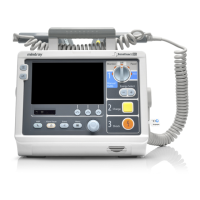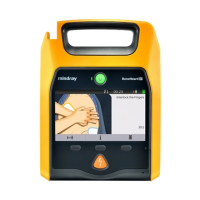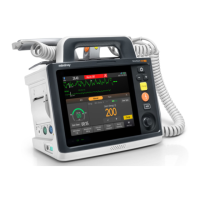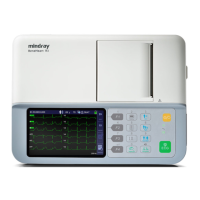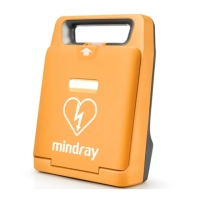Defibrillator/Monitor Operator’s Manual 7 - 7
• Using internal paddles for synchronized cardioversion requires that the patient’s ECG be acquired
through a standard ECG cable. The patient’s ECG acquired through the internal paddles may be
unreliable for synchronized cardioversion due to excessive noise or artifact causing inappropriate R-
wave detection.
• When you access synchronized cardioversion, monitoring alarms is reactivated autonomously.
7.5.1 Performing Synchronized Cardioversion
1. Connect the therapy cable and apply the electrode pads or external paddles to the patient. If ECG set is
used for ECG monitoring, connect the ECG trunk cable and apply the ECG electrodes to the patient. For
detail, refer to 5.4Preparing for ECG Monitoring and Measurement.
2. Switch the Mode Select knob to Manual Defib, and press the [Enter Sync] soft key to activate the
synchronized cardioversion function.
3. Select a lead. The selected lead should have a clear signal and a large QRS complex.
4. Verify that a white R-wave marker appears above each R-wave If the R-wave markers do not appear or do
not coincide with the R-waves, for example above the T-waves, select another lead.
5. Verify that you access synchronized cardioversion, as indicated by the SYNC marker shown in the
defibrillation information area.
6. Press the Energy Select button to select a desired energy level.
7. Press the Charge button on the equipment, if using external paddles, the Charge button located on the
handle of Apex paddle.
8. Confirm that a shock is still indicated and that the equipment has charged to the selected energy level.
Make sure no one is touching the patient, bed or any equipment connected to the patient. Call out loudly
and clearly “Stay Clear”.
9. Press and hold the Shock button on the equipment or, if using external paddles, the Shock buttons on both
paddles. The shock will be delivered when the next R-wave is detected.
E
• During synchronized cardioversion, it is important to continue to hold the shock button (or the
paddle’s Shock buttons) until the shock is delivered. The equipment shocks with the next detected
R-wave.
7.5.2 Delivering Additional Synchronized Shocks
If additional synchronized shocks are indicated, perform the following steps:
1. Make sure the equipment is still in Sync mode, as indicated by the presence of the Sync message in the
defibrillation information area.
2. Repeat steps 4 to 9 as described in 7.5.1Performing Synchronized Cardioversion.
If [Sync After Shock] is set to [Ye s ], the equipment remains in the sync mode after a shock is delivered; if set to
[No], the equipment exits the sync mode and enters the asynchronous defibrillation mode after a shock.
7.5.3 Disabling the Sync Function
To disable the Sync function, press the [Exit Sync] soft key.

